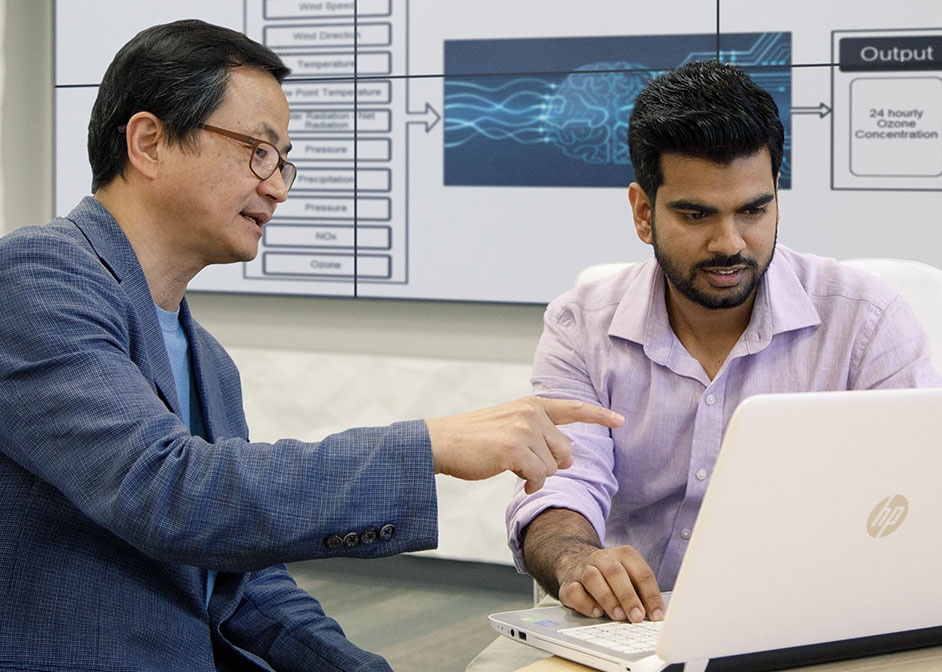Artificial Intelligence Breakthrough Gives Longer Advance Warning of Ozone Issues
Atmospheric Science Research Team Finds “Holy Grail” of Air Quality Forecasting
Ozone levels in the earth’s troposphere (the lowest level of our atmosphere) can now be forecasted with accuracy up to two weeks in advance, a remarkable improvement over current systems that can accurately predict ozone levels only three days ahead. The new artificial intelligence (AI) system developed in the University of Houston’s Air Quality Forecasting and Modeling Lab could lead to improved ways to control high ozone problems and even contribute to solutions for climate change issues.

“This was very challenging. Nobody had done this previously. I believe we are the first to try to forecast surface ozone levels two weeks in advance,” said Yunsoo Choi, professor of atmospheric chemistry and AI deep learning at UH’s College of Natural Sciences and Mathematics. The findings are published online in the journal, Scientific Reports–Nature.
Ozone, a colorless gas, is helpful in the right place and amount. As a part of the earth’s stratosphere (“the ozone layer”), it protects by filtering out UV radiation from the sun. But when there are high concentrations of ozone near earth’s surface, it is toxic to lungs and hearts.
Breakthrough: Ozone Forecasting Up to 14 Days Ahead
“Ozone is a secondary pollutant, and it can affect humans in a bad way,” explained doctoral student Alqamah Sayeed, a researcher in Choi’s lab and the first author of the research paper. Exposure can lead to throat irritation, trouble breathing, asthma, even respiratory damage. Some people are especially susceptible, including the very young, the elderly and the chronically ill.

Ozone levels have become a frequent part of daily weather reports. But unlike weather forecasts, which can be reasonably accurate up to 14 days ahead, ozone levels have been predicted only two or three days in advance – until this breakthrough.
The vast improvement in forecasting is only one part of the story of this new research. The other is how the team made it happen. Conventional forecasting uses a numerical model, which means the research is based on equations for the movement of gasses and fluids in the atmosphere.
The limitations were obvious to Choi and his team. The numerical process is slow, making results expensive to obtain, and accuracy is limited. “Accuracy with the numerical model starts to drop after the first three days,” Choi said.
Development of Machine Learning Algorithm
The research team used a unique loss function in developing the machine learning algorithm. A loss function helps in optimization of the AI model by mapping decision to their associated costs. In this project, researchers used index of agreement, known as IOA, as the loss function for the AI model over conventional loss functions. IOA is a mathematical comparison of gaps between what is expected and how things actually turn out.
In other words, team members added historical ozone data to the trials as they gradually refined the program’s reactions. The combination of the numerical model and the IOA as the loss function eventually enabled the AI algorithm to accurately predict outcomes of real-life ozone conditions by recognizing what happened before in similar situations. It is much like how human memory is built.
“Think about a young boy who sees a cup of hot tea on a table and tries to touch it out of curiosity. The moment the child touches the cup, he realizes it is hot and shouldn’t be touched directly. Through that experience, the child has trained his mind,” Sayeed said. “In a very basic sense, it is the same with AI. You provide input, the computer gives you output. Over many repetitions and corrections, the process is refined over time, and the AI program comes to ‘know’ how to react to conditions that have been presented before. On a basic level, artificial intelligence develops in the same way that the child learned not to be in such a hurry to grab the next cup of hot tea.”
4-5 Years of Data Used to “Teach” the AI System
In the lab, the team used four-to-five years of ozone data in what Sayeed described as “an evolving process” of teaching the AI system to recognize ozone conditions and estimate the forecasts, getting better over time.
“Applying deep learning to air quality and weather forecasting is like searching for the holy grail, just like in the movies,” said Choi, who is a big fan of action plots. “In the lab, we went through some difficult times for a few years. There is a process. Finally, we’ve grasped the holy grail. This system works. The AI model ‘understands’ how to forecast. Despite the years of work, it somehow still feels like a surprise to me, even today.”
Before success in the laboratory can lead to real-world service, many commercial steps are ahead before the world can benefit from the discovery.
“If you know the future – air quality in this case – you can do a lot of things for the community. This can be very critical for this planet. Who knows? Perhaps we can figure out how to resolve the climate change issue. The future may go beyond weather forecasting and ozone forecasting. This could help make the planet secure,” said Choi.
Sounds like a happy ending for any good action story.
Sally Strong, University Media Relations

